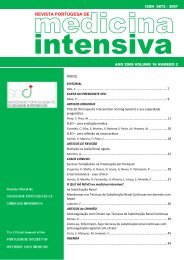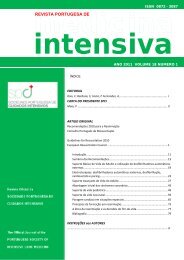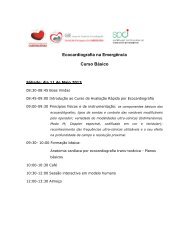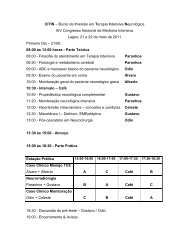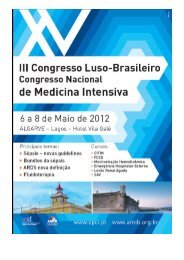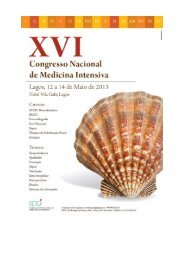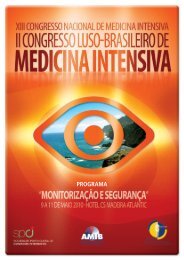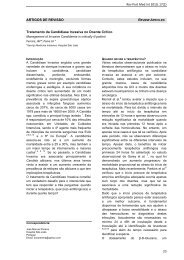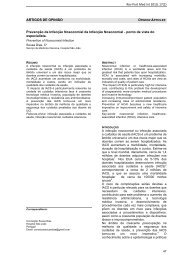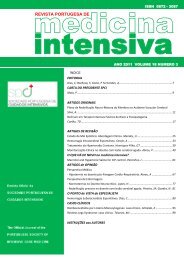Dezembro de 2009 - Vol 16 numero 3 - Sociedade Portuguesa de ...
Dezembro de 2009 - Vol 16 numero 3 - Sociedade Portuguesa de ...
Dezembro de 2009 - Vol 16 numero 3 - Sociedade Portuguesa de ...
You also want an ePaper? Increase the reach of your titles
YUMPU automatically turns print PDFs into web optimized ePapers that Google loves.
Rev Port Med Int <strong>2009</strong>; <strong>Vol</strong> <strong>16</strong>(3)<br />
consequently be able to optimize their<br />
treatments: how is the volume status (VS), how<br />
are the left (LV) and right ventricle (RV)<br />
functions, how are the chambers, how is the<br />
pericardium and are there any other gross<br />
abnormalities (mobile mass on valves or in<br />
chambers).<br />
OBJECTIVES<br />
The aim of this study was to evaluate, through<br />
an exten<strong>de</strong>d contemporary literature review,<br />
whether echocardiography can accurately<br />
evaluate haemodynamic parameters in or<strong>de</strong>r<br />
to i<strong>de</strong>ntify the haemodynamic profile of<br />
HUP/PIS. As well, The author propose Fast-<br />
Track Echocardiographic Strategy (FTES) to<br />
become a goal-directed approach, to be used<br />
in these patients to answer five simple<br />
questions, in or<strong>de</strong>r to <strong>de</strong>fine an hemodynamic<br />
profile: how is the volume status, how are the<br />
left and right ventricle functions, how are the<br />
chambers, how is the pericardium (cardiac<br />
tampona<strong>de</strong>) and are there any other<br />
abnormalities (mobile mass on valves or in<br />
chambers).<br />
METHODOS<br />
A search for published literature from 1999<br />
until June <strong>2009</strong> in Medline, Cochrane Central<br />
Register of Controlled Trials Library, ACP<br />
Journal Club, DARE, EMBASE, textbooks of<br />
critical care and of echocardiography and in<br />
some critical care journals was un<strong>de</strong>rtaken in<br />
or<strong>de</strong>r to find out the most relevant and<br />
contemporary studies in this area. From more<br />
than 500 published articles and textbooks<br />
i<strong>de</strong>ntified, more than 50 studies and themes<br />
were selected which used methodologies able<br />
to offer strengths of evi<strong>de</strong>nce type 2b, 3a, 3b, 4<br />
and 5. Randomized control trials were not<br />
found. Strength of evi<strong>de</strong>nce of the articles<br />
found was based on five strengths of evi<strong>de</strong>nce<br />
12 . A framework for published medical<br />
research’s critical appraisal and a checklist for<br />
sources of bias were used 12 for assessment of<br />
studies quality.<br />
LITERATURE ANALYSIS AND DISCUSSION<br />
The importance of the echocardiography in<br />
HUP/PIS<br />
Overall, according to the literature, it could be<br />
recognized as a B level of recommendation<br />
that echocardiography should be performed in<br />
all critically ill HUP/PIS due to its ability to<br />
evaluate accurately their haemodynamic<br />
profiles and to provi<strong>de</strong> several aspects of the<br />
systolic and diastolic function. Also,<br />
echocardiography could be a gui<strong>de</strong> to therapy.<br />
For example, Cheitlin et al (2003) 13 performed<br />
a systematic literature review study to<br />
elaborate the 2003 gui<strong>de</strong>lines for the clinical<br />
application of echocardiography and 9 cohort<br />
studies were selected to evaluate the role of<br />
echocardiography in the critical care<br />
environment. In these gui<strong>de</strong>lines, with a<br />
strength of evi<strong>de</strong>nce type 3a,<br />
echocardiography, including the<br />
transoesophageal (TOE) approach, was<br />
recommen<strong>de</strong>d to be used in the assessment of<br />
the haemodynamically unstable patient as a<br />
class I of American College of Cardiology /<br />
American Heart Association / American<br />
Society of Echocardiography (ACC/AHA/ASE)<br />
recommendation. These authors suggested<br />
that echocardiography could be more reliable<br />
than invasive monitoring measured by PAC in<br />
<strong>de</strong>termining the cause of haemodynamic<br />
instability or shock. The 9 cohort studies<br />
enrolled more than 600 critically ill patients with<br />
a wi<strong>de</strong> range of critically ill clinical situation,<br />
and more than 200 patients had<br />
haemodynamic instability as the primary<br />
reason for echocardiographic examination.<br />
Recently, other study 14 with a strength of<br />
evi<strong>de</strong>nce type 3b, could <strong>de</strong>monstrate that<br />
echocardiography should be performed in all<br />
kind of patients with the syndrome of shock<br />
due to the high capability to differentiate<br />
accurately a cardiac cause, a cardiac<br />
contribution, because the heart could be<br />
secondarily affected, or a non-cardiac cause<br />
for shock.<br />
Pre-load evaluation by echocardiography<br />
The effective vascular volume evaluation by<br />
echocardiography<br />
The first <strong>de</strong>terminant of the CO to be evaluated<br />
should be the pre-load one. It is imperative to<br />
know, accurately, what the patient’s<br />
intravascular volume status is. If the volume<br />
status is <strong>de</strong>pleted, the patient would benefit<br />
from therapy with fluids. On the other hand, if<br />
the volume status is overloa<strong>de</strong>d, the patient<br />
would benefit from a <strong>de</strong>crease in his<br />
intravascular volume status in or<strong>de</strong>r to avoid<br />
the consequent pulmonary oe<strong>de</strong>ma and<br />
ultimately the <strong>de</strong>terioration of the oxygenation.<br />
The knowledge of the effective vascular<br />
volume could possibly be much more important<br />
than the fixed numbers of CVP or RAP values.<br />
A method able to <strong>de</strong>fine the real effective<br />
vascular volume differentiating patients who<br />
would respond to fluid, increasing at least 15%<br />
of their cardiac in<strong>de</strong>x, and consequently be a<br />
gui<strong>de</strong> to therapy, has been searched for, for a<br />
long time. On the contrary, in a non-fluid<br />
respon<strong>de</strong>r patient a blind fluid challenge would<br />
create only conditions to interstitial fluid<br />
accumulation and consequently to make gas<br />
exchange worse. For that reason, some<br />
authors have investigated whether<br />
echocardiography could be able to differentiate<br />
fluid respon<strong>de</strong>rs from non-fluid respon<strong>de</strong>rs.<br />
Barbier et al (2004) 15 performed a prospective<br />
cohort study, (which is one of the strongest<br />
research tools able to show that the cause is<br />
37



